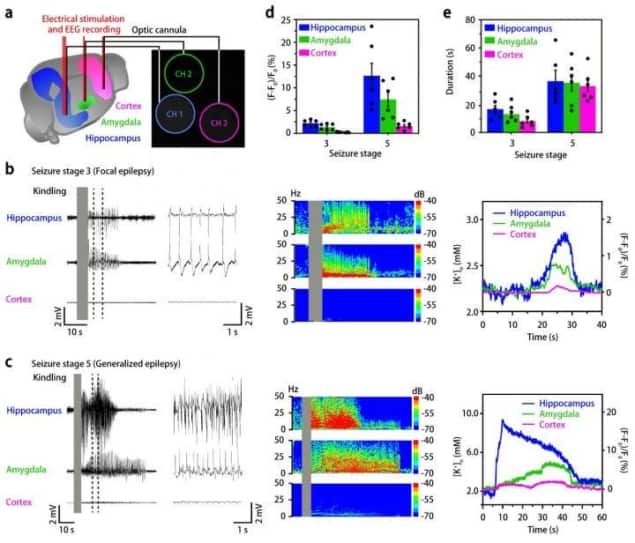
A new, highly sensitive nanosensor can detect changes in potassium ion levels in the brains of mice as they undergo induced epileptic seizures. The device, developed by researchers at the Institute for Basic Science (IBS) in South Korea and Zhejiang University in China, can record changes in multiple brain regions at the same time, and could thus further our understanding of the mechanisms behind epilepsy and other neurological disorders.
The presence of potassium ions (K+) outside the confines of nerve cells, or neurons, affects the electric potential difference between neurons’ interior and exterior membranes. When the concentrations of these extracellular ions change, the neurons’ ability to transmit signals changes with it. Some such changes are known to be related to chronic neurological disorders such as epilepsy – a condition that affects 1 in 100 people worldwide, and is characterized by recurrent and unpredictable seizures that often have no apparent external trigger.
Sensing small changes in the levels of K+ is important because it might make it possible to predict an imminent epileptic seizure, but most such sensors today cannot do this – particularly in freely-moving animals. They are also susceptible to interference from sodium ions (Na+) because the efflux of K+ is preceded by an influx of Na+ when electric impulses travel along the membrane of a neuron.
Potassium selective
The new nanosensor, which was developed in a team led by Zhong Chen and Daishun Ling at Zhejiang University and Taeghwan Hyeon at the IBS, overcomes these problems. The device consists of an optical potassium indicator (a dye molecule that fluoresces in the presence of K+) embedded in mesoporous silica nanoparticles shielded by an ultrathin layer of a potassium-permeable membrane. This membrane is very similar to the potassium channel in brain cells, and the pore size of the nanoparticles prevents other cations (including Na+) from reaching the indicator. This means the device captures K+ ions exclusively, and can detect their presence at concentrations as low as 1.3 micromoles per litre. Thanks to this high sensitivity, the researchers were able to spatially map sub-millimolar variations of extracellular K+ in three different regions of the mouse brain: the hippocampus, amygdala and cortex.
After injecting the nanosensors into various locations within the brain of a test mouse, the team electrically simulated the mouse’s hippocampus to induce an epileptic seizure and recorded the nanosensors’ optical responses. They then compared these readings with those obtained from simultaneous measurements made using conventional electroencephalography (EEG). They found that in localized epileptic seizures, the extracellular K+ concentration increases from the hippocampus to the amygdala and cortex over time, while in generalized seizures it increases almost simultaneously in all three brain regions.
The researchers say that these results back up the widely-accepted view that electrical stimulation in the hippocampus first involves the adjacent brain area and then propagates through the entire brain. “We expect that our multipoint K+ measurements in freely-moving animals will be a useful technique in neuroscience for examining the functional connections between sub-regions of the brain, as well as neuronal activities occurring in disorders like epilepsy,” they tell Physics World.

Treating epilepsy with physics
Towards whole-brain imaging
The team plan to use their device to detect how seizure activity spreads through the entire brain during an epileptic seizure. Looking further ahead, they would also like to develop tissue-penetrating near-infrared emission-based K+ sensors that could be used to precisely detect epileptic foci. “Such a device might help in the diagnosis and treatment of epilepsy and even reduce the need for surgery,” they explain. “If loaded with antiepileptic drugs and coated with nanocomposites that can be disrupted by elevated K+ levels, these nanosensors might even allow for highly localized and on-demand drug release at the point of a seizure,” they say.
The device, which is described in Nature Nanotechnology, might also be adapted to detect cations other than K+ with high sensitivity and specificity, they add.



